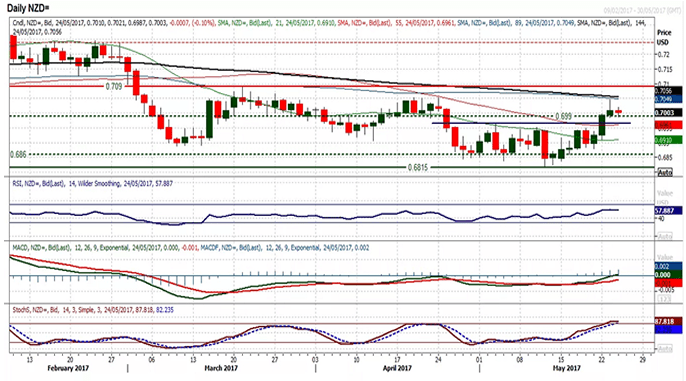The New Zealand Dollar: From Zero to Hero

The backdrop of a softer USD and firmer commodities prices has supported commodity-linked currencies.
The outperformance in this sector has been broad-based but the New Zealand Dollar is seen leading the way.
“NZD has gone from zero to hero in the space of two trading days as increasingly bullish expectations for the upcoming Budget and Fonterra dairy payout forecasts come to the fore, prompting short covering from systematic accounts,” says Sue Trinh, Head of Asia FX Strategy at RBC Capital Markets.
The New Zealand Dollar now buys 0.7029 USD.
One Pound now buys 1.8475 NZD, having gone as high as 1.8963 earlier in the month.
“On the other end of the spectrum, GBP underperformed following the failure to break 1.3050 (against the USD) and reports of a fatal explosion in Manchester at a concert venue,” says Trinh.
Those making international payments on GBP/NZD will be seeing their banks offering payment rates in the region of 1.7836 to 1.7965. Independent payment providers are seen offering in the region of 1.8317 however, a big saving. More details here.
Inflection Point
The headline NZD/USD exchange rate is important as often moves here feed through into GBP/NZD.
The NZD has also made a "remarkable recovery" against the greenback in the last week or so notes analysts Richard Perry with Hantec Markets, a retail trading brokerage based in the UK.
However, the analyst questions whether the New Zealand Dollar has what it takes to push higher from here.
"The momentum indicators have been improving for over a week now and with two positive sessions the momentum is increasingly positive," says Perry. "However, the market seems to be at something of an inflection point once more."
Recent price action has seen the NZD/USD rate move mildly lower and is pulling back to an old pivot at $0.6990.
"If this support between the neckline at $0.6970 and pivot at $0.6990 now starts to build then the near term recovery can continue towards the near term breakout target. However, the momentum indicators are though at a crossroads now with the RSI into the mid-high 50s, whilst the Stochastics are now around 80 and MACD lines expanding but back to neutral. Can the bulls sustain the recent recovery and build higher?" asks Perry.
"There are question marks over the recovery, with yesterday’s high at $0.7046 before drifting lower into the close. This is an interesting inflection point for the Kiwi," adds the analyst.
For NZD, a Non-Oil Producing Country, OPEC Meeting Could Matter
As mentioned, the global market backdrop remains the biggest short-term driver for the NZ Dollar and should a cautious risk environment merge once more we would expect the high-beta currency universe that the NZD inhabits under pressure.
“A positive outcome at the OPEC meeting could provide a buffer for commodity currencies via the global risk sentiment channel), but this is more a supporting factor for NZD if anything,” says a note from ING Bank N.V.
The meeting is due on May 25 and it is expected oil producing markets will agree to extend production limits which should in turn keep prices elevated.
Domestic Agenda: Budget and Milk Prices
On the domestic scene, the New Zealand Dollar might take a lead from Fonterra’s opening season milk price forecast for the 2017/18 season, which will be announced on Wednesday, May 24.
“We are expecting Fonterra to kick off the season with a slightly cautious milk price forecast of around $6/kg of milk solids. This contrasts to our end-of-season forecast of $6.75/kg and current spot prices which are sitting around $6.50/kg. However, Fonterra often starts the season on a cautious note. However, as we have seen this season, we expect milk prices to lift over the season and Fonterra to periodically revise prices higher as the season continues,” says Kim Mundy and economist with ASB.
Following Fonterra’s announcement, the Government is due to release its 2017 Budget on Thursday, May 25.
This year the Budget will be slightly different in that Bill English is no longer the Minister of Finance as he has been for the previous 8 years.
This is a Steven Joyce budget and, given that it is also an election year, could markets be in for a few surprises?
“In actual fact, we are expecting much of the same in Thursday’s budget. Not only because Bill English was previously the Minister of Finance (and is now Prime Minister), but also because the books are likely to remain very healthy given the strength in the NZ economy,” says Mundy.
As at March 2017, the operating balance before gains and losses (OBEGAL) was running ahead of forecast by around $1.3bn.
“If this trend continues, the Budget is likely to signal an increased surplus to end the 2017 fiscal year and reconfirm surpluses over the Budget forecasting horizon. In other words, we are expecting to see a lot of black,” says Mundy.
Yet, as the ASB economist points out, healthy books do open the door for more spending.
Tax cuts, in the form of a one-off lift to thresholds may be on the cards according to Steven Joyce.
This would help counter the recent effects of fiscal drag. In addition, Joyce has hinted at a possible boost to Working for Families.
“While small tweaks might be made to the Government’s spending plans, we expect the Government to remain focused on stated goals around further reducing net debt. As a result, the Budget is likely to show that the Government continues to meet its net debt target of 20% of GDP by 2020 and then reaches 15% or less by 2025,” says Mundy.





